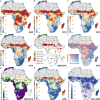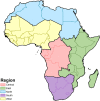Mapping child growth failure in Africa between 2000 and 2015
- PMID: 29493591
- PMCID: PMC6346257
- DOI: 10.1038/nature25760
Mapping child growth failure in Africa between 2000 and 2015
Abstract
Insufficient growth during childhood is associated with poor health outcomes and an increased risk of death. Between 2000 and 2015, nearly all African countries demonstrated improvements for children under 5 years old for stunting, wasting, and underweight, the core components of child growth failure. Here we show that striking subnational heterogeneity in levels and trends of child growth remains. If current rates of progress are sustained, many areas of Africa will meet the World Health Organization Global Targets 2025 to improve maternal, infant and young child nutrition, but high levels of growth failure will persist across the Sahel. At these rates, much, if not all of the continent will fail to meet the Sustainable Development Goal target-to end malnutrition by 2030. Geospatial estimates of child growth failure provide a baseline for measuring progress as well as a precision public health platform to target interventions to those populations with the greatest need, in order to reduce health disparities and accelerate progress.
Conflict of interest statement
This study was funded by the Bill & Melinda Gates Foundation. Co-authors employed by the Bill & Melinda Gates Foundation provided feedback on initial maps and drafts of this manuscript. Otherwise, the funders of the study had no role in study design, data collection, data analysis, data interpretation, or the writing of the final report. The corresponding author had full access to all the data in the study and had final responsibility for the decision to submit for publication.
Figures










Comment in
-
Precision maps for public health.Nature. 2018 Mar 1;555(7694):32-33. doi: 10.1038/d41586-018-02096-w. Nature. 2018. PMID: 29493618 No abstract available.
References
-
- GBD 2016 Risk Factors Collaborators. Global, regional, and national comparative risk assessment of 84 behavioural, environmental and occupational, and metabolic risks or clusters of risks, 1990–2016: a systematic analysis for the Global Burden of Disease Study 2016. Lancet 390, 1345–1422 (2017) - PMC - PubMed
-
- Black R. E. et al. Maternal and child undernutrition: global and regional exposures and health consequences. Lancet 371, 243–260 (2008) - PubMed
-
- Pelletier D. L. & Frongillo E. A. Changes in child survival are strongly associated with changes in malnutrition in developing countries. J. Nutr. 133, 107–119 (2003) - PubMed
-
- World Health Organization & United Nations Children’s Fund. WHO Child Growth Standards and the Identification of Severe Acute Malnutrition in Infants and Children: A Joint Statement (WHO Press, 2009) - PubMed
-
- Wang Y. & Chen H.-J. in Handbook of Anthropometry (ed.Preedy V. R.) 29–48 (Springer, 2012)
Publication types
MeSH terms
Grants and funding
LinkOut - more resources
Full Text Sources
Other Literature Sources
Medical

